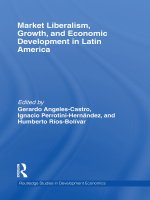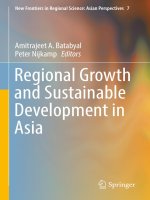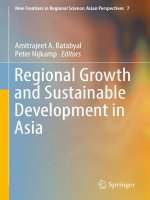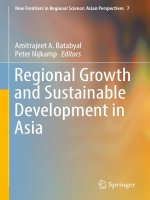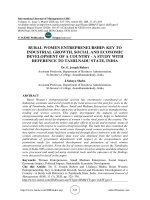Economic growth and economic development 95
Bạn đang xem bản rút gọn của tài liệu. Xem và tải ngay bản đầy đủ của tài liệu tại đây (84.49 KB, 1 trang )
Introduction to Modern Economic Growth
until the 1970s have made many economists prefer models with balanced growth
to those without. It is not literally true that the share of capital in output and
the capital-output ratio are exactly constant. For example, since the 1970s both the
capital share and the capital-output ratio may have increased depending on how one
measures them. Nevertheless, constant factor shares and a constant capital-output
ratio are a good approximation to reality and a very useful starting point for our
models.
Also for future reference, note that the capital share in national income is about
1/3, while the labor share is about 2/3. We are ignoring the share of land here as we
did in the analysis so far: land is not a major factor of production. This is clearly
not the case for the poor countries, where land is a major factor of production.
It is useful to think about how incorporating land into this framework will change
the implications of our analysis (see Exercise 2.7). For now, it suffices to note that
this pattern of the factor distribution of income, combined with economists’ desire
to work with simple models, often makes them choose a Cobb-Douglas aggregate
production function of the form AK 1/3 L2/3 as an approximation to reality (especially
since it ensures that factor shares are constant by construction).
For us, the most important reason to start with balanced growth is that it is
much easier to handle than non-balanced growth, since the equations describing
the law of motion of the economy can be represented by difference or differential
equations with well-defined steady states. Put more succinctly, the main advantage
from our point of view is that balanced growth is the same as a steady-state in
transformed variables–i.e., we will again have k˙ = 0, but the definition of k will
change. This will enable us to use the same tools developed so far to analyze
economies with sustained growth. It is nevertheless important to bear in mind
that in reality, growth has many non-balanced features. For example, the share of
different sectors changes systematically over the growth process, with agriculture
shrinking, manufacturing first increasing and then shrinking. Ultimately, we would
like to have models that combine certain quasi-balanced features with these types
of structural transformations embedded in them. We will return to these issues in
Part 7 of the book.
81
